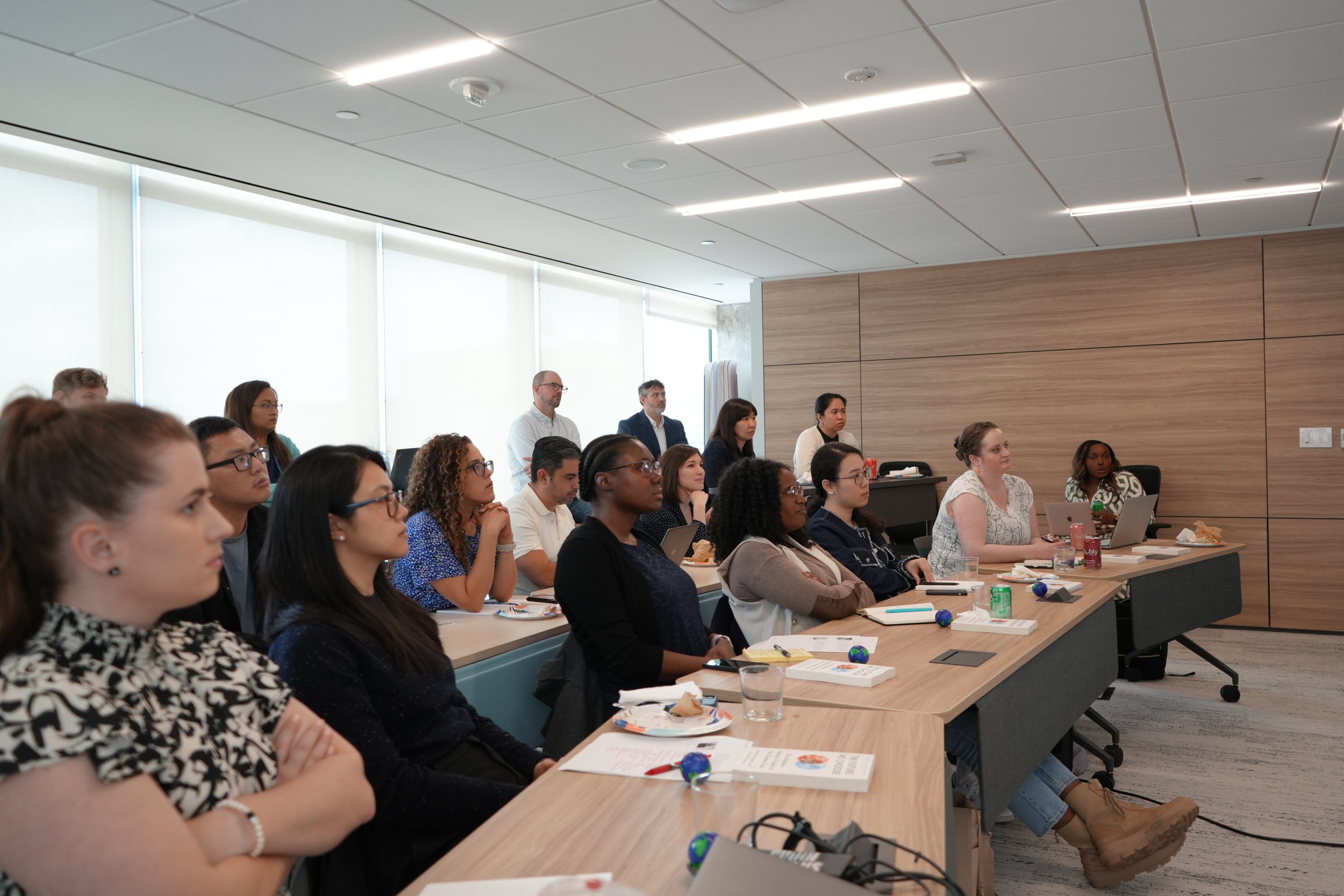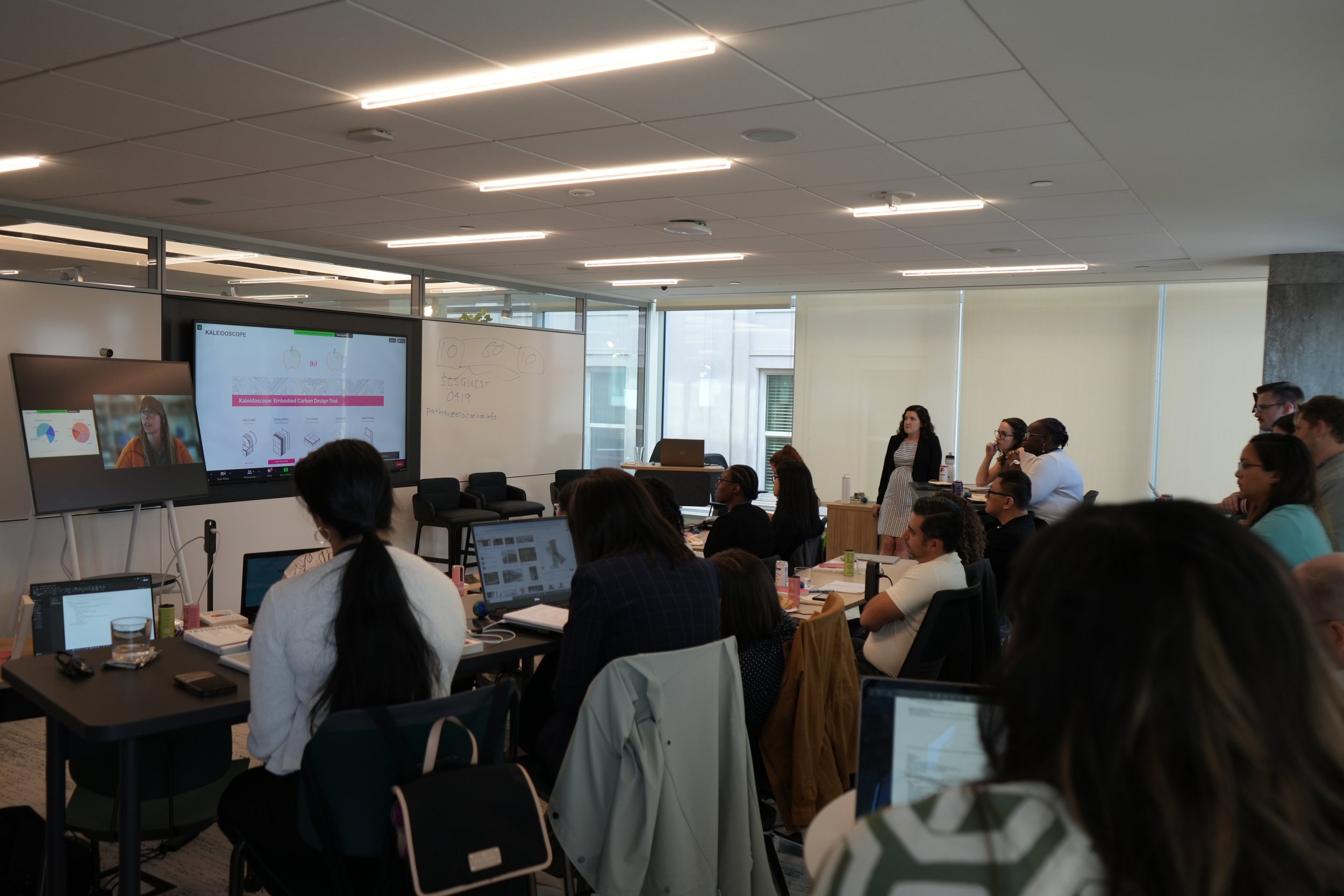S3: Tackling Climate Change
April 12th, 2024
Location: Steelcase Showroom
Led by: Nia Furr and Denise Gravelle, AIA, LEED AP BD+C
For the third session of CKLDP, scholars focused on the pervasive issue of climate change and the powerful role that architects have in impacting energy usage and carbon emissions from the building industry. The presentations centered on how the definition of sustainability has evolved, evaluating green policies and incentives have been put in place in the DMV region, and exploring the tools that different disciplines have to teach clients and make decisions about sites and materials. The session provided valuable perspective on the challenges faced by architects and encouraged the scholars to consider the opportunities to improve human health and well being through sustainable strategies.
Act 1: Defining “Sustainability”
Justin Schwartzhoff, AIA, LFA, LEED AP BD+C
This presentation described the overall shift in thinking on sustainability within the building industry from energy usage and stormwater management, towards a focus on embodied carbon, health, and human rights. Justin highlighted the need to consider a full life cycle analysis for projects, taking into account extraction, manufacturing, transportation, assembly, and operation and systems, and emphasized that the most carbon intensive steps in the process are those at the beginning of the cycle. He provided a list of best sustainable practices for the main structural systems in use, encouraging flexibility, as many strategies have co benefits and tradeoffs down the line. Justin also pointed to the importance of having sustainability professionals within our firms and creating a community that can share information and enact change.
Casey Ross, PE, LEED AP, GGP, BEMP & Shane Trexler, LEED AP O+M
This presentation by Casey Ross and Shane Trexler took a more detailed look at policy and cost, in particular the incentives introduced through the Inflation Reduction Act and the Building Energy Performance Standards (BEPS) in DC which are becoming a model for other programs across the country. Shane began the presentation by comparing the bonus density strategy utilized in Arlington County with the BEPS strategy, noting that, in either case, the owners’ awareness and ability to set expectations for the project are key. Casey focused on the Climate Solutions Now Act in Maryland which aims for a 100% reduction in building generated greenhouse gas emissions by 2045. He described the incentives and penalties that would adjust over time through a series of case studies, and explained how this will impact how and when we advise our clients to make the shift to all electric. The group discussed the implications for historic buildings across different jurisdictions and the initial burden on owners and renters.
Act 2: The Cost of Climate Change
This panel discussion combined the sustainability insights of three design professionals from different disciplines; James, a project manager at the structural engineering firm, SK+A, Arathi, a principal at ZGF Architects, and Ryan, a principal at Moody Graham Landscape Architecture. James began the conversation with some actionable design strategies for structure which focused on efficiency in material usage and analysis of specific areas rather than applying the same standards across a whole building. Arathi spoke to the west coast mentality, centered on the importance of the natural landscape, and her mission to bring that perspective to her practice on the east coast. She identified changing minds as the main challenge to sustainability, and establishing trust and clear, persuasive communication as the solution. Ryan looked at climate change from the perspective of resilience and argued that designers should adopt the attitude of embracing and preparing for change, rather than simply working to prevent change. He discussed the role that districtwide infrastructure and community engagement had in dealing with the flood threat at Buzzard Point. The panel additionally covered the effectiveness of “stealth advocacy” and the how making meaningful connections with professionals in adjacent fields will improve outcomes.
James Chavin-Grant, PE, SE, CDT, Arathi Gowda, AIA, AICP, LFA, LEED AP BD+C & Ryan Moody, PLA, ASLA
Act 3: How We Do It
Melanie Silver brought the session to a close with a presentation on life cycle analysis and a workshop that taught the scholars how to utilize Payette’s Kaleidoscope design tool which looks at materials and assemblies through a variety of lenses including global warming potential and health impacts. She began with a case study on reducing embodied carbon at the Penn State Engineering Design and Innovation Building where Payette proposed a timber curtain wall that could perform similarly to an aluminum curtain wall but with the added benefit of deeper mullions that would reduce glare.
Melanie then led the scholars in a quick design charette for a low carbon office building in Baltimore with the goals of meeting the clients’ desires for a modern but contextual facade with easy maintenance. The presentation finished with a reflection on the impacts of interior improvements on overall embodied carbon which is often overlooked, but can add up quickly due to the surprising frequency of renovations in commercial spaces.









